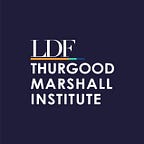Racial Disparities in New York State’s Vaccine Distribution
by Kesha S. Moore, Ph.D., Senior Researcher, Thurgood Marshall Institute
In New York State, like much of the nation, Black and Latinx communities have the highest rates of death from COVID-19. Yet, their higher vulnerability of dying from COVID-19 has not afforded them priority access to the life-saving vaccine.
The Johns Hopkins Center for Health Security recommends that the highest priority access be given to individuals with the greatest risks of severe illness and death and their caregivers. Giving priority access to those at the highest risks of severe illness and death from COVID-19 is ethically and pragmatically sound. Prioritizing populations most burdened by COVID-19 will save lives and reduce the strain on the health care infrastructure. Despite comprising nearly half of all COVID-19 deaths in New York State, Black and Latinx residents of New York have received less than 20% of the state’s vaccinations.
This pattern of racial discrepancies between rates of COVID-19 deaths and vaccinations is consistent across all 10 regions of New York State. It is yet another example of how structural racism privileges the health and well-being of people identified as White while increasing the mortality of people identified as non-White. In every region within New York State, White people received more than their fair share of the limited vaccine supply. A national study by the Surgo Foundation indicates that approximately 30% of Black people “highly desire” the vaccine. Another 25% of Black people reported that they would like to take the vaccine within the first three months of release. Thus, it is unlikely that “vaccine hesitancy” is responsible for the current racial disparities we see in vaccine distribution within New York.
Figure 2 presents the difference between the group population in New York State and the groups’ portion of vaccinations thus far. The bars closest to the line suggest that groups receive their fair share of the vaccinations given their proportion in the population. The bars above and below the line suggest that groups receive more than (above the line) or less than (below the line) their fair share of vaccinations given their percentage of the state’s population. New York City has the most pronounced form of racial disparity in vaccine allotment throughout the state. In New York City, White residents received 6% more access to the COVID-19 vaccine while Black residents received 11% less and Latinx residents received 9% less than their proportion of the population. Long Island and Mid-Hudson have the largest vaccine disparity for Latinx vaccinations. Latinx residents in Long Island received approximately 10% fewer vaccinations than their proportion, and Latinx residents in Mid-Hudson received 9% less.
Black and Latinx communities bear the brunt of the pandemic while being deprived of the resources available to protect their lives. Given the racialized structure of the U.S. economy, Black and Latinx workers are more likely to be employed in “essential” jobs requiring them to risk their own health and their families' health to remain employed. Even when required to return to these front-line jobs during a pandemic, these workers were often not given the appropriate personal protective equipment (PPE) to keep them safe. Read the Thurgood Marshall Institute’s recommendations for protecting Black workers. Now that we have another protective resource in our fight against COVID-19, we should not deny them of this resource as well.
The four principles identified by the Center for Disease Control (CDC) advisory committee on immunization recommend that vaccine distribution be organized to (1) maximize benefits and minimize harms, (2) promote justice, (3) mitigate health inequalities, and (4) promote transparency. Having COVID-19 case and vaccination data reported by race enables transparency and accountability. Without such data, we might be unaware of the extreme racial inequalities created by our social policies and practices and the harms it produces on individuals and communities of color.
